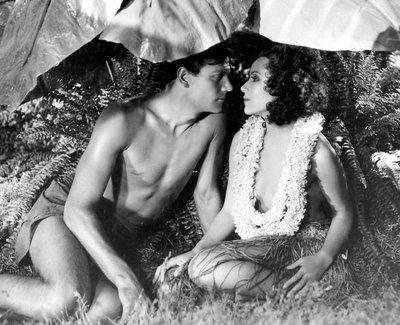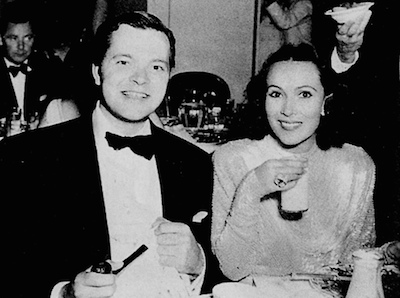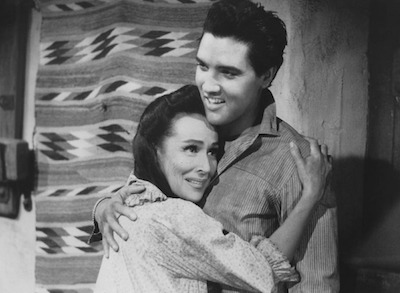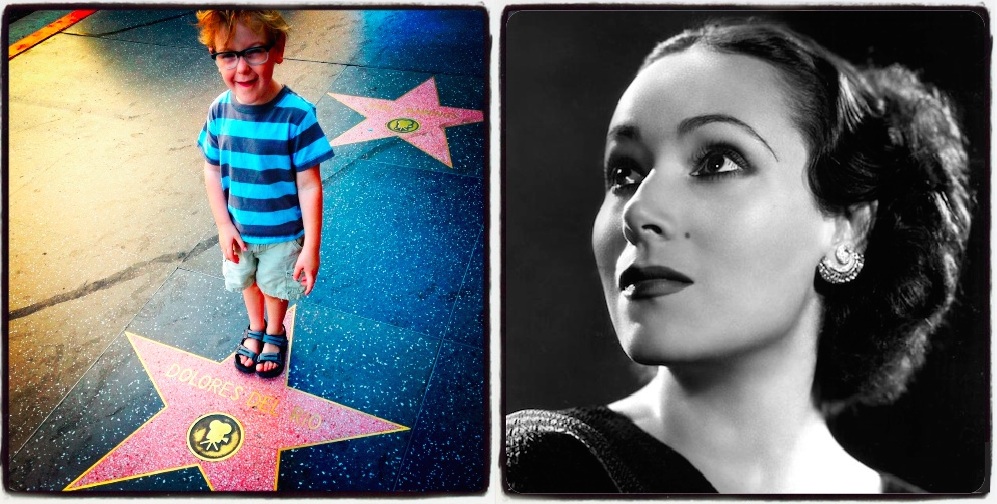 A weekly feature in which my five-year-old son is let loose on the Hollywood Walk of Fame, one of the most popular tourist attractions in Los Angeles, and chooses a star from among the more than 2,500 honorees. His “random” picks sometimes reveal unexplained connections such as the summer day in 2012 when he sat down on the star of actress Celeste Holm and refused to budge. We later learned that the Oscar-winning actress had died only hours earlier. There are five categories on the Walk of Fame: motion pictures, television, radio, music and theater but Charlie tends to favor the movies.
A weekly feature in which my five-year-old son is let loose on the Hollywood Walk of Fame, one of the most popular tourist attractions in Los Angeles, and chooses a star from among the more than 2,500 honorees. His “random” picks sometimes reveal unexplained connections such as the summer day in 2012 when he sat down on the star of actress Celeste Holm and refused to budge. We later learned that the Oscar-winning actress had died only hours earlier. There are five categories on the Walk of Fame: motion pictures, television, radio, music and theater but Charlie tends to favor the movies.
This week Charlie chose Mexican-born movie goddess Dolores del Rio. Born on August 3, 1905, in Durango, Mexico, she was the first Latina to become a big star in Hollywood. She later lost interest in the American star system and returned to her native country where she became a key figure in the Golden Age of Mexican cinema. I have to admit that when Charlie first hopped onto del Rio’s star, the only film that came to mind was her 1933 RKO extravaganza, Flying Down to Rio, that is more noted today as the first film to team Fred Astaire with a young 22-year-old contract player by the name of Ginger Rogers. By the time she made this film, 28-year-old Dolores was an old pro with many films under her belt.
Discovered in the early 1920s by director Edwin Carewe, the glamorous del Rio was a sensation in silent films, promoted as a kind of female Rudolph Valentino, a feminine Latin Lover. A favorite cover girl on the movie magazines of the day, some of del Rio’s most popular silent films included What Price Glory? (1926), Resurrection (1927), Ramona (1928), and Evangeline (1929). Unlike many of her contemporaries, especially those with foreign accents, Dolores made the transition to talkies with ease.
 In 1932, del Rio shocked audiences by taking a nude swim with Joel McCrea in King Vidor’s pre-code film Bird of Paradise. Following the success of Flying Down to Rio, she played the title character in William Dieterle’s Madame Du Barry (1934), starred in Busby Berkeley’s I Live for Love (1935), and played a knife thrower charged with murder opposite Douglas Fairbanks, Jr. in Accused (1936). But in 1937, the actress refused to appear in the popular film Viva Villa! starring Wallace Beery as revolutionary Pancho Villa because she considered the film anti-Mexican. By the end of the 1930s, thanks to a series of stereotypical roles in which she mostly played “exotic” characters that were poorly conceived, she was labeled “box office poison.” Del Rio hightailed it back to Mexico where she began making a series of celebrated Spanish-language films such as Flor Silvestre (1942), Maria Candelaria (1943), Las Abandonadas (1944), and Bugambilia (1944). She still did occasional films in Hollywood during this time, including the classic Journey Into Fear (1942) with Joseph Cotten.
In 1932, del Rio shocked audiences by taking a nude swim with Joel McCrea in King Vidor’s pre-code film Bird of Paradise. Following the success of Flying Down to Rio, she played the title character in William Dieterle’s Madame Du Barry (1934), starred in Busby Berkeley’s I Live for Love (1935), and played a knife thrower charged with murder opposite Douglas Fairbanks, Jr. in Accused (1936). But in 1937, the actress refused to appear in the popular film Viva Villa! starring Wallace Beery as revolutionary Pancho Villa because she considered the film anti-Mexican. By the end of the 1930s, thanks to a series of stereotypical roles in which she mostly played “exotic” characters that were poorly conceived, she was labeled “box office poison.” Del Rio hightailed it back to Mexico where she began making a series of celebrated Spanish-language films such as Flor Silvestre (1942), Maria Candelaria (1943), Las Abandonadas (1944), and Bugambilia (1944). She still did occasional films in Hollywood during this time, including the classic Journey Into Fear (1942) with Joseph Cotten.
 Dolores del Rio’s personal life was followed by fans around the world. She got married at the age of 16 to a wealthy Mexican socialite Jaime Martinez del Rio but he quickly became disenchanted with Hollywood and the couple divorced in 1928. Del Rio’s second husband was famed MGM production designer Cedric Gibbons (who also designed the Oscar statuette). After their ten-year marriage ended in 1940, del Rio began a tempestuous relationship with Orson Welles, ten years her junior. They broke up after four years and Welles married actress Rita Hayworth but according to his daughter with Hayworth, Rebecca Welles, the actor/director remained obsessed with del Rio for the rest of his life. “My father considered her the great love of his life, she was a living legend in the history of my family.” Del Rio’s third husband was producer Lewis A. Riley. The actress gave frequent parties during her Hollywood years. Her close friends in Hollywood included Greta Garbo, Marlene Dietrich (who called Dolores the most beautiful woman in Hollywood), Errol Flynn, and Myrna Loy.
Dolores del Rio’s personal life was followed by fans around the world. She got married at the age of 16 to a wealthy Mexican socialite Jaime Martinez del Rio but he quickly became disenchanted with Hollywood and the couple divorced in 1928. Del Rio’s second husband was famed MGM production designer Cedric Gibbons (who also designed the Oscar statuette). After their ten-year marriage ended in 1940, del Rio began a tempestuous relationship with Orson Welles, ten years her junior. They broke up after four years and Welles married actress Rita Hayworth but according to his daughter with Hayworth, Rebecca Welles, the actor/director remained obsessed with del Rio for the rest of his life. “My father considered her the great love of his life, she was a living legend in the history of my family.” Del Rio’s third husband was producer Lewis A. Riley. The actress gave frequent parties during her Hollywood years. Her close friends in Hollywood included Greta Garbo, Marlene Dietrich (who called Dolores the most beautiful woman in Hollywood), Errol Flynn, and Myrna Loy.
 When I mentioned Charlie’s choice to my wife, she told me that when he was a young reporter at the Dallas Morning News, her father, Oliver Hailey, who would later move to Los Angeles and became a successful playwright and Emmy-nominated TV writer, got to interview Dolores del Rio when she was passing through town. Being a huge movie fan, he was thrilled to meet the actress. I was able to track down my late father-in-law’s fascinating article from July 6, 1959.
When I mentioned Charlie’s choice to my wife, she told me that when he was a young reporter at the Dallas Morning News, her father, Oliver Hailey, who would later move to Los Angeles and became a successful playwright and Emmy-nominated TV writer, got to interview Dolores del Rio when she was passing through town. Being a huge movie fan, he was thrilled to meet the actress. I was able to track down my late father-in-law’s fascinating article from July 6, 1959.
Movies are NOT better than ever, insisted Mexican beauty Dolores del Rio this weekend. And as authority for her argument, the lady frankly admitted she’s been around long enough to know.
Evaluating an industry she has seen stretch from the silents to stereophonic sound, Miss del Rio said that films may be technically better than ever, but the plots are not up to par.
“All that sound and color and those enormous screens — it’s absolutely amazing, of course, but it doesn’t matter if you don’t have a good story. That’s the important thing.”
So important for Miss del Rio that she deserted top stardom in Hollywood — in films such as “What Price Glory?” and “Flying Down to Rio” — to become an “actress” in her native country.
“In Hollywood, I became a kind of super mannequin. I was dressed in beautiful clothes, put in front of beautiful sets, and then stood around doing nothing,” smiled the actress, dressed in Chinese silk.
But on a Mexican holiday some 14 years ago, she discovered a group of “intelligent people” pioneering with filmmaking in Mexico City.
“They wanted to create meaningful motion pictures, and I saw a chance to do some real acting. The money was small, but I already had all of that fame and fortune, and I knew it wasn’t enough, I wanted to be an actress.”
The brown-haired-and-eyed beauty has since made some 24 Mexican films, many capturing international prizes. If Hollywood beckoned again, would the lovely lady return?
“I would love to go back, if they sent me a good story. They call practically every year, but the part is never right. They still have me typed. They don’t understand. I don’t do that type of work anymore.”
 Hollywood eventually did beckon with some projects that del Rio felt were more worthy. She played Elvis Presley’s mother in Don Siegel’s Flaming Star, appeared in John Ford’s Cheyenne Autumn (1964) with Richard Widmark and Carroll Baker, and played Omar Sharif’s mother in More Than a Miracle (1967) with Sophia Loren. Her final film role was in The Children of Sanchez (1978) with Anthony Quinn and Katy Jurado. On April 11, 1983, Dolores del Rio died of liver disease at the age of 77. Thanks to Charlie and to his grandfather, Oliver Hailey, for helping me remember this beautiful and ground-breaking actress.
Hollywood eventually did beckon with some projects that del Rio felt were more worthy. She played Elvis Presley’s mother in Don Siegel’s Flaming Star, appeared in John Ford’s Cheyenne Autumn (1964) with Richard Widmark and Carroll Baker, and played Omar Sharif’s mother in More Than a Miracle (1967) with Sophia Loren. Her final film role was in The Children of Sanchez (1978) with Anthony Quinn and Katy Jurado. On April 11, 1983, Dolores del Rio died of liver disease at the age of 77. Thanks to Charlie and to his grandfather, Oliver Hailey, for helping me remember this beautiful and ground-breaking actress.


